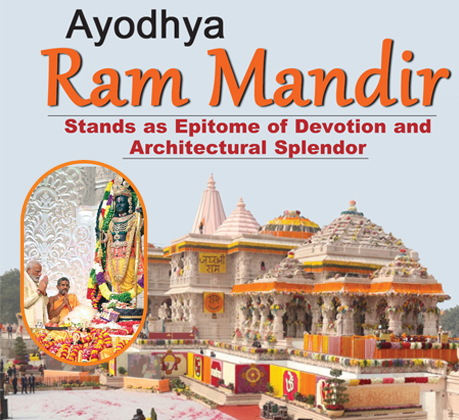Stands as Epitome of Devotion and Architectural Splendor
Indian Prime Minister Talks About` Lord Ram’s Teachings
Prime Minister Narendra Modi conveyed that Lord Ram dwells within each person, underscoring that the teachings of Lord Ram serve as the bedrock of Bharat’s culture, deeply embedded in the hearts of the people. The majestic Ram Mandir in
Ayodhya is poised to embody the essence of our culture and heritage, magnifying its significance on the global platform. Envisioned not only as a temple but also as a profound embodiment of shared values, cultural abundance, and a universal
spiritual ethos, the monumental structure resonates far beyond geographical boundaries.
In a momentous occasion that fulfilled the dreams of millions, Indian Prime Minister Narendra Modi spearheaded the consecration ceremony on January 22 for the grand temple dedicated to the Hindu god Lord Ram. The ceremony took place at a
site believed to be the birthplace of Lord Ram, marking the pinnacle of efforts to construct the Ayodhya Ram Mandir, also known as the Shri Ram Mandir. The significance of this event resonated not only with the Hindu majority in India but
also garnered global attention, with crores (hundreds of millions) of people witnessing the historic moment through live television and internet streaming. Prime Minister Modi had laid the foundation stone for the temple on August 5, 2020,
following a prolonged struggle spanning over 500 years.
At its core, the Ayodhya Ram Mandir stands as a symbol of devotion and reverence towards Lord Ram, an iconic figure deeply rooted in Hinduism. The temple’s construction and consecration represent a collective vision to establish a sacred
space, embodying the cultural and spiritual ethos of the nation.
This journey towards the inauguration of the Shri Ram Mandir extends beyond a mere construction project; it is a manifestation of faith, unity, and a testament to India’s rich and enduring cultural heritage. Lord Ram, revered as the
quintessential hero of the Hindu epic Ramayana, transcends the boundaries of mythology. His worship is widespread across India and beyond, representing virtue, righteousness, and Dharma-the cosmic order governing the universe. His timeless
story, depicting the triumph of good over evil, continues to inspire millions across generations.
Architectural Splendor
Ayodhya Ram Mandir Showcases Nagara Style and Earthquake-Proof Design
The newly inaugurated Ram Mandir in Ayodhya stands not only as a testament to religious significance but also showcases the architectural brilliance of the Nagara style, predominantly observed in temple construction. The Nagara style,
characterized by towering spires or shikhara, intricate carvings, and a vertical emphasis, finds expression in various regions, including Orissa, parts of North India, Gujarat, and Rajasthan.
Nagara architecture’s unique features contribute to the grandeur and spiritual significance of the temple, creating a sacred and visually captivating structure. In the context of the Ram Mandir, the Nagara style pays homage to the rich
architectural heritage of the regions from which it draws inspiration.
“The temple is anticipated to reach around 161 feet in height, encompassing a vast area of 28,000 square feet. Spanning three levels and covering 2.7 acres, the ground floor of the Ram Mandir portrays the life of Lord Ram, offering
devotees a visual narrative of his journey. The first floor provides a captivating experience of Lord Ram’s court, immersing visitors in the divine ambiance. Mainly constructed using the Bansi Paharpur stone from Bharatpur, Rajasthan, the
Ram Mandir showcases the stone’s renowned pink hue and royal look. This choice of material adds to the temple’s aesthetic appeal and reflects a commitment to traditional craftsmanship.
As the Ram Mandir opens its doors to devotees, it not only stands as a symbol of religious devotion but also exemplifies the harmonious blend of architectural heritage and spiritual significance. The Nagara style, earthquake-proof design,
and meticulous planning by the Sompura family contribute to the temple’s magnificence, inviting visitors to experience the divine in a structure that pays homage to Lord Ram’s legacy.
A distinctive aspect of the Ram Mandir is its construction using only stone, with no iron or steel involved, ensuring the structure’s earthquake-proof resilience. The renowned architect Chandrakant Sompura and his children are credited with
the magnificent design of the temple. According to the Sompura family, the temple’s construction plans were conceived thirty years ago by Ashish Sompura, son of Chandrakant Sompura.
An ode To Ancient Myths:
Engraving Shri Ram on The Bricks of Ram Mandir
Beyond its architectural splendor, the Ram Mandir in Ayodhya boasts a unique fusion of ancient traditions and modern engineering, ensuring a structure that stands not only as a place of worship but also as a testament to enduring cultural
practices.
The noteworthy practice of inscribing ‘Shri Ram’ on the bricks used in the temple’s construction harks back to an ancient tradition. This sacred inscription, believed to enhance strength and durability, establishes a timeless connection to
the revered figure of Lord Ram. The incorporation of this practice infuses the contemporary structure with spiritual significance and an assurance of longevity.
The holy Ram Mandir stretches an impressive 360 feet in length and 235 feet in width, reaching a height of 161 feet, inclusive of its peak. Boasting three floors and 12 gates, the temple stands as a Engraving Shri Ram on The Bricks of Ram
Mandir An ode To Ancient Myths: splendid architectural magnificence, drawing devotees and admirers alike.
In a move to preserve the temple’s historical significance for future generations, a time capsule has been buried at a depth of 2000 feet beneath the temple. This capsule contains a copper plate engraved with crucial details about the
temple, Lord Ram, and Ayodhya. The initiative aims to encapsulate the essence of this momentous occasion, safeguarding the rich cultural and historical heritage associated with the Ram Mandir As the doors of the Ram Mandir open to devotees,
it is not merely a place of worship but a living testament to the seamless integration of age-old traditions and contemporary engineering. The sacred inscriptions, grand dimensions, and the time capsule collectively contribute to an
architectural marvel that will stand as a beacon of cultural and spiritual heritage for generations to come. The Ram Mandir, with its roots in tradition and eyes on the future, symbolizes the enduring legacy of Lord Ram and the timeless
connection between the past and the present.
Shri Ram Mandir’s Foundation:
A Tapestry of Unity Woven from Soil of 2587 Places
The foundation of the Shri Ram Mandir in Ayodhya stands as a unique testament to the spirit of unity in India’s rich tapestry of cultures and religions. Infused with spiritual meaning, the foundation is made with soil collected from 2587
different places across the country, symbolizing the amalgamation of sacred and pious qualities from diverse regions.
This symbolic gesture represents a connection to the varied cultures and religions that make India truly unique. The incorporation of soil from significant locations, including Jhansi, Bithoori, Haldighati, Yamunotri, Chittorgarh, and the
Golden Temple, holds profound meaning. Each of these spots carries its own history and significance, contributing to the rich cultural fabric of the nation.
The act of incorporating soil from these diverse locations signifies a deep-seated desire to honor andconnect with the unique histories and importance associated with each spot. As a result, when visitors step into the temple, they are not
just connecting with one place but with the entire country and its diverse traditions. The Shri Ram Mandir becomes a symbol of unity in diversity, fostering a sense of connection and shared heritage among its devotees.
This beautiful and symbolic gesture of bringing soil from various parts of the country creates `a spiritual and cultural bridge, transcending geographical boundaries. It encapsulates the essence of India’s unity, where people from different
regions and backgrounds come together to contribute to the creation of a sacred space. The foundation of the Shri Ram Mandir reflects the inclusive spirit that defines the cultural landscape of India, inviting all to experience and
celebrate the diverse traditions that make the country truly extraordinary.
Sculptor Arun Yogiraj’s Vision:
Shri Ram and Devi Sita Idols in Ram Mandir
In a significant stride towards the completion of the Ram Mandir, a masterpiece Murti crafted from Krishna Shila by renowned sculptor Arun Yogiraj takes center stage, adding an unparalleled touch of sacred significance to the upcoming
inauguration ceremony.
Arun Yogiraj, celebrated for his commitment to the art of sculpting, has poured his expertise into creating a Murti that not only showcases meticulous detailing but also emanates a profound spiritual essence. The decision to use Krishna
Shila for the statue holds immense importance, marking a pivotal Shri Ram Mandir’s Foundation: A Tapestry of Unity Woven from Soil of 2587 Places step in the journey of completing the Ram Mandir.
Yogiraj’s choice of canvas for this divine creation is the captivating Krishna Shila stone, abundant in the Mysuru and HD Kote districts. True to its name, the stone bears a striking resemblance to Lord Krishna’s complexion, a deep,
lustrous black that lends itself perfectly to intricate carving. The calcite composition of Krishna Shila makes it initially soft and pliable, ideal for shaping and sculpting, before gradually hardening over time, lending an `enduring
quality to the masterpiece.
Yogiraj’s meticulous approach to sculpting reflects in the idol’s breathtaking details. Chisels of varying sizes dance across the stone, guided by his masterful vision, to bring forth intricate patterns and lifelike features. Hammers and
the finest chisels add the final touches, ensuring a visual symphony that celebrates both the divine essence of Ram Lalla and Yogiraj’s artistic prowess.
Crafted with precision and dedication, the statue stands as a testament to Arun Yogiraj’s artistic prowess and his deep connection to the spiritual essence of the subject matter. Krishna Shila, chosen for its unique qualities, adds a
distinctive touch to the Murti, enhancing its sacred significance.
During the grand inauguration, Arun Yogiraj’s masterpiece becomes a focal point, embodying not just the skill of the sculptor but also the reverence and devotion that have gone into the creation of this sacred symbol. The Krishna Shila
Murti stands poised to become a cherished component of the Ram Mandir, resonating with the spiritual aspirations of devotees and adding a touch of divine grace to the momentous ceremony. More than just an idol, Yogiraj’s creation stands as
a testament to the rich artistic heritage of Mysore. From the depths of the captivating Krishna Shila stone, through the skilled hands of Arun Yogiraj, emerges a divine symbol that embodies faith, artistry, and enduring devotion.
Kali Gandaki Shaligram Enhances Ram Mandir’s Spiritual Idol
In a meticulous adherence to religious traditions, the Ram Mandir in Ayodhya takes a significant stride by using the sacred Shaligram stone sourced from the Kali Gandaki River in Nepal for the construction of the Ram idol. This carefully
chosen stone not only upholds essential significance in Hinduism but also connects the temple to the spiritual essence of the revered river.
The Shaligram stone, believed to represent Lord Vishnu, holds profound importance in Hindu worship. Devotees believe that worshiping this stone brings forth blessings in the form of wealth, joy, and prosperity to their lives. By selecting
the Shaligram stone for the construction of the Ram sculpture, the builders of the Ram Mandir demonstrate a deep respect for religious traditions and a commitment to infusing spiritual significance into every facet of the temple.
This unique choice of stone not only symbolizes Lord Vishnu but also connects the temple to the sacred energy associated with the Kali Gandaki River in Nepal. The use of the Shaligram stone transcends the creation of a mere statue; it
becomes a symbolic vessel, believed to carry the blessings and positive energy associated with Lord Vishnu in Hindu beliefs.
As the Ram Mandir prepares for its grand inauguration, the choice of the Shaligram stone becomes a testament to the careful consideration given to spiritual and religious elements in the construction process. The idol crafted from this
sacred stone is poised to become a focal point, embodying not only the essence of Lord Ram but also the divine blessings believed to be inherent in the Shaligram, adding an extra layer of spiritual significance to this momentous occasion.
Ayodhya Celebrates the Return of Lord Ram
The streets of Ayodhya are aglow with lights and adorned with flowers, showcasing vibrant murals that depict scenes from the Ramayana on various city walls. Along the prominent roads, majestic sun-themed pillars, known as “Surya Stambh,”
stand tall, featuring a golden orb at their summits, reminiscent of the night sun.
Adding to the festive atmosphere, cultural programs such as Ram Leelas grace the city, featuring performances by troupes from both India and around the world. Traditional folk performances add to the cultural tapestry of the celebration.
Troupes hailing from countries like Cambodia, Singapore, Thailand, Nepal, and Sri Lanka have been specially invited to participate in the grand Ramotsav. This global participation underscores the widespread influence of Indian mythology and
culture on a global scale.
Ram Mandir: Major Economic Boost for City and State

















Add Comment